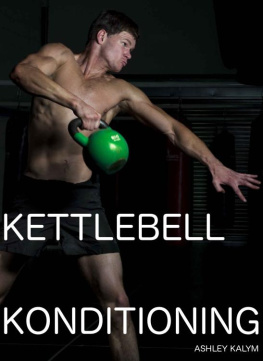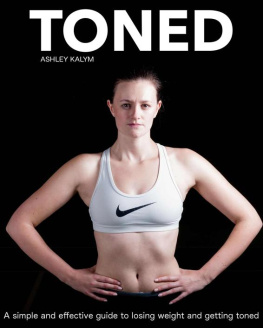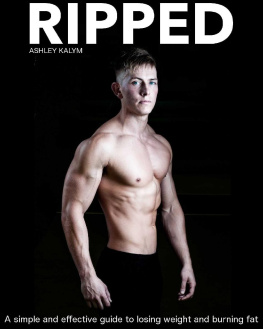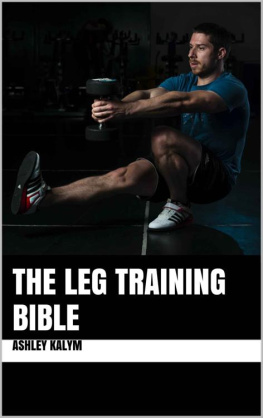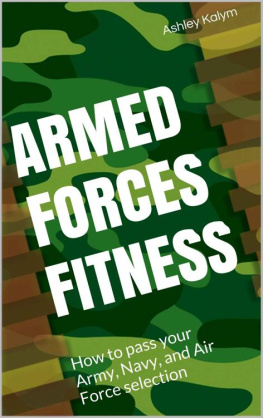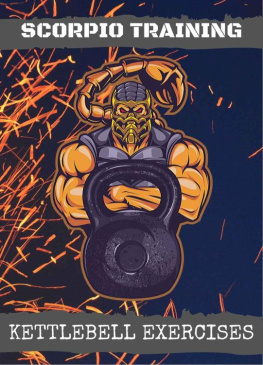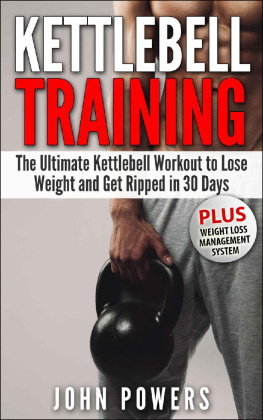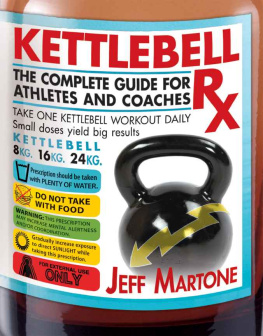Ashley Kalym - Kettlebell Konditioning
Here you can read online Ashley Kalym - Kettlebell Konditioning full text of the book (entire story) in english for free. Download pdf and epub, get meaning, cover and reviews about this ebook. year: 2013, publisher: Ashley Kalym, genre: Science. Description of the work, (preface) as well as reviews are available. Best literature library LitArk.com created for fans of good reading and offers a wide selection of genres:
Romance novel
Science fiction
Adventure
Detective
Science
History
Home and family
Prose
Art
Politics
Computer
Non-fiction
Religion
Business
Children
Humor
Choose a favorite category and find really read worthwhile books. Enjoy immersion in the world of imagination, feel the emotions of the characters or learn something new for yourself, make an fascinating discovery.
- Book:Kettlebell Konditioning
- Author:
- Publisher:Ashley Kalym
- Genre:
- Year:2013
- Rating:4 / 5
- Favourites:Add to favourites
- Your mark:
- 80
- 1
- 2
- 3
- 4
- 5
Kettlebell Konditioning: summary, description and annotation
We offer to read an annotation, description, summary or preface (depends on what the author of the book "Kettlebell Konditioning" wrote himself). If you haven't found the necessary information about the book — write in the comments, we will try to find it.
Kettlebell Konditioning — read online for free the complete book (whole text) full work
Below is the text of the book, divided by pages. System saving the place of the last page read, allows you to conveniently read the book "Kettlebell Konditioning" online for free, without having to search again every time where you left off. Put a bookmark, and you can go to the page where you finished reading at any time.
Font size:
Interval:
Bookmark:
Kettlebell Konditioning
Kettlebell Konditioning is an awesome guide showing you how to develop your strength, power, athletic ability, and all round fitness using this most simple piece of equipment.
Contained inside are exercises to develop the whole of the body, including the shoulders, back, legs, and core. We will also look at a number of circuits that will help to melt away body fat and leave you with a ripped and trim physique!
Copyright 2012 Ashley Kalym
All rights reserved. No portion of this book, whether in print or electronic format, may be duplicated or transmitted without written permission of the publisher, except where permitted by law.
Acknowledgements
Many thanks must go to Chris Frosin for the photography and design work, and also to Jon Leonard for the use of Funktion Fitness.
Check out more of Chris Frosins photography work at; www.chrisfrosin.co.uk
Check out Jon Leonards awesome gym at; www.funktionfitness.com
The kettlebell is one of the oldest yet most effective training methods that exists, and can provide a strength, endurance, skill, cardiovascular, and agility workout in one go!
The kettlebell was developed in Russia in the 1700s, and were used in the physical training and development of soldiers for a long time, even up to this day. In recent years use of the kettlebell has seen a resurgence in popularity, especially in the west, where modern gyms and organizations have introduced it to an excellent reception. As the kettlebell has not been used much by the general public before, like it has in places such as Russia, it has the benefit of being a new and exciting way of training, even though it has been used for decades in other parts of the world.
The kettlebell has quickly built up a cult following by its adherents, and has been incorporated into many athletes training programs as a tool used for promoting and increasing strength, power, and athletic ability. It has also enjoyed some success as a rehab tool, especially for the lower back.
Organisations such as CrossFit have welcomed the kettlebell with open arms, including it in many of their workout of the days, or WODs, and doing much to promote its popularity.
The beauty of a piece of equipment such as the kettlebell is that it remains effective whether it goes out of fashion or not. Many new pieces of equipment that have emerged in recent years have a huge following for a small amount of time, before going out of fashion just as quickly.
In essence the kettlebell is a very simple piece of equipment. It could best be described as a cannonball with a handle, and in effect thats what it is. They come in varying sizes, anywhere from 4kg to 40kg, usually with a thin rubber coating to protect the hands and the floor from impacts. The kettlebell has three main parts, namely the bell, the handle, and the horns. The following picture shows a standard kettlebell.
In some places you will see phrases such as 1 pood kettlebell, or 1.5 pood kettlebell. In Russia, 1 pood is equal to just over 16kg, or 36lbs. So, a 16kg kettlebell is also known as a 1-pood kettlebell, and a 24kg kettlebell is called a 1.5 pood kettlebell.
In this next section we will take a look at all of the exercises that are available to us. For ease, I have divided them into body parts so that you may work on certain areas on different days. The exercises are divided into the following sections:
Posterior chain This refers the muscles in the back of the body, including the hamstrings, glutes, and back. The posterior chain is probably the most important area of the body to train if you are interested in developing strength and power for athletics and sports performance. The posterior chain is responsible for a movement known as hip drive, which is the action of hip extension, or moving the hips from a closed angle to an open angle. Running, jumping, and lunging are all examples of hip drive in action.
Shoulders The shoulders are used in pushing movements and stabilisation of the upper body. Push-ups, dips, and overhead pressing are all exercises where the shoulders are used extensively.
Core The core is one of the most important areas of the body to train, and kettlebells are perfect for working the core. The core can be thought of as the foundation of the body, and no movement can take place effectively without a strong core. This is true regardless of the activity or sport you are participating in. If you have a strong core then the arms and legs and other areas of the body have something solid to grab onto, and your movements and strength will be better as a result.
Biceps The biceps are worked by curling movements, and are responsible for decreasing the angle of the elbow joint, and also in stabilisation of the elbow itself when the arm is straight.
Legs If you wish to raise your metabolism, burn fat, and increase your athletic potential, then you must work the legs. The lower body contains all of the biggest muscles in the body, including the glutes, quads, hamstrings, and adductors, and working these will elicit a hormonal and endocrine response in the body.
Chest The chest is also involved in the majority of pushing movements, and also helps to stabilise the shoulder joint.
Back The back is responsible for the pulling type movements, and helps to give that V shape that we all want.
Triceps Together with the chest and shoulders the triceps are also responsible for the pushing type movements, and are tasked with increasing the angle at the elbow, or straightening the arm.
The posterior chain is one of the most important parts of the body to train, especially if you are concerned with developing overall strength and power, especially if you play sports or compete in athletic pursuits. The posterior chain consists of the muscles in the rear of the body, and these muscles are the largest and most powerful muscles in the human body. Training these muscles is also essential if your are looking to lose weight, as the amount of energy you will use when performing posterior chain exercises is very high, and elicits a greater hormonal response than almost any other type of movement.
The kettlebell swing is the most simple kettlebell exercise and the starting point for many of the other movements. It is simultaneously a strength, technique, and conditioning movement, and can be made very challenging by using a heavy kettlebell.
The swing can be performed with one or two hands, and is best suited for timed rounds instead of the traditional sets and repetitions.
To perform the swing grasp the kettlebell handle with both hands, with your palms facing back towards you. Your feet should be slightly wider than hip width apart, and your knees should be slightly bent.
To start the swing, allow the kettlebell to move between your legs. Bend at the hips aiming to keep the lower back straight. As the kettlebells momentum backwards slows, attempt to push the hips forward, using the large muscles of the legs, bum, and back to straighten the body. This action will force the kettlebell to swing forward. Keep the arms straight and the shoulders relaxed. If you start to feel your shoulders tiring quickly, you are most likely not using your lower body enough in the movement.
The normal swing requires you to stop the kettlebell once it gets to eye level. If you wish, you can carry on the swing until the weight is overhead. If you do this then make sure that you keep a firm grip on the handle, as the last thing you want is for the kettlebell to fall on your head!
The normal swing and the overhead swing are shown in the pictures that follow.


Font size:
Interval:
Bookmark:
Similar books «Kettlebell Konditioning»
Look at similar books to Kettlebell Konditioning. We have selected literature similar in name and meaning in the hope of providing readers with more options to find new, interesting, not yet read works.
Discussion, reviews of the book Kettlebell Konditioning and just readers' own opinions. Leave your comments, write what you think about the work, its meaning or the main characters. Specify what exactly you liked and what you didn't like, and why you think so.

